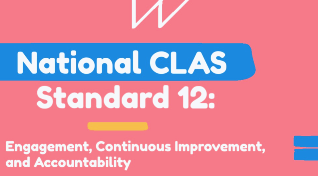Standard 12 | Conduct regular assessments of community health assets and needs and use the results to plan and implement services that respond to the cultural and linguistic diversity of populations in the service area.
Purpose | Helps to determine the services assets and needs of the populations in the service areas (needs assessment); To identify all of the services available and not available to the populations in the service areas (resources inventory and gaps analysis); To determine what services to provide and how to implement them, based on the results of the community assessment; To ensure that health and health care organizations obtain demographic, cultural, linguistic, and epidemiological baseline data (quantitative and qualitative) and update the data regularly to better understand the populations in their services area.
Strategies for Achievement | Examples of Strategies:
- Collaborate with other organizations and stakeholders in data collection, analysis, and reporting efforts to increase data reliability and validity
- Review demographic data collected with local health and health care organizations (QSource, 2005)
For additional strategies, see “The Blueprint“ an implementation guide to help you advance and sustain CLAS within your organization.
The Checklist | Work with your team to complete this Implementation Checklist for the National CLAS Standards to find areas of opportunity and create your CLAS Action Worksheet!
The Great Plains QIN team developed a simple video to outline the National CLAS Standard 12. If you have questions or would like technical assistance on how to implement the National CLAS Standards, contact a member of the Great Plains QIN Team.


